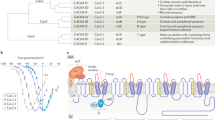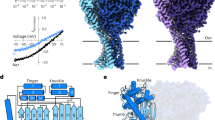Abstract
A TWO component postsynaptic inhibition recorded from a group of identifiable neurones of the pleural ganglia of Aplysia has been recently described. It is composed of a rapidly decaying, chloride dependent component, and a more slowly decaying, potassium dependent component1,2. An ionophoretic injection of acetylcholine (ACh) onto cells showing this two component inhibition produces a response which also has two components. As with the synaptic potential, the initial, more rapid phase is chloride dependent and the delayed, more slowly decaying phase is potassium dependent1. That ACh is the transmitter responsible for both phases of the synaptic inhibition was further indicated by the fact that the chloride dependent component of both the synaptic and ACh potentials was completely blocked by d-tubocurarine or strychnine1,2, whereas the potassium dependent component—unaffected by these drugs—was selectively suppressed by the addition of tetra-ethyl-ammonium chloride (TEA-Cl) to the external medium2. These data suggest that the two component inhibition is caused by a single transmitter (ACh) acting on two pharmacologically distinct receptors and triggering two different permeability changes in the postsynaptic cells.
This is a preview of subscription content, access via your institution
Access options
Subscribe to this journal
Receive 51 print issues and online access
$199.00 per year
only $3.90 per issue
Buy this article
- Purchase on Springer Link
- Instant access to full article PDF
Prices may be subject to local taxes which are calculated during checkout
Similar content being viewed by others
References
Kehoe, J. S., Nature, 215, 1503 (1967).
Kehoe, J. S., CR Acad. Sci., 268, 111 (1969).
Hagiwara, S., and Tasaki, I., J. Physiol., 143, 114 (1958).
Takeuchi, A., and Takeuchi, N., J. Gen. Physiol., 45, 1181 (1962).
Miledi, R., and Slater, C. R., J. Physiol., 184, 473 (1966).
Kusano, K., Livengood, D. R., and Werman, R., J. Gen. Physiol., 50, 2579 (1967).
Harvey, A. M., and MacIntosh, F. C., J. Physiol., 97, 408 (1940).
del Castillo, J., and Katz, B., J. Physiol., 124, 553 (1954).
Tauc, L., in Structure and Function of Inhibitory Neuronal Mechanisms, Proc. Fourth Intern. Meet. Neurobiologists, Sept. 1966, 377–382 (Pergamon, 1968).
Wachtel, H., and Kandel, E. R., Science, 158, 1206 (1967).
Author information
Authors and Affiliations
Rights and permissions
About this article
Cite this article
KEHOE, J. Single Presynaptic Neurone mediates a Two Component Postsynaptic Inhibition. Nature 221, 866–868 (1969). https://doi.org/10.1038/221866a0
Received:
Revised:
Issue Date:
DOI: https://doi.org/10.1038/221866a0
This article is cited by
-
A monosynaptic connection between the medial nociceptive and the Nut cell in leech ganglia
Journal of Comparative Physiology A (1985)
-
Ionic dependence of acetylcholine equilibrium potential of acinar cells in mouse submaxillary gland
Pfl�gers Archiv European Journal of Physiology (1980)
-
Synaptic responses mediated by identified histamine-containing neurones
Nature (1977)
-
Biphasic Action of Glutamic Acid and Synaptic Inhibition in an Identified Serotonin-containing Neurone
Nature New Biology (1973)
-
Re-evaluation of the Synaptic Activation of an Electrogenic Sodium Pump
Nature (1970)
Comments
By submitting a comment you agree to abide by our Terms and Community Guidelines. If you find something abusive or that does not comply with our terms or guidelines please flag it as inappropriate.



